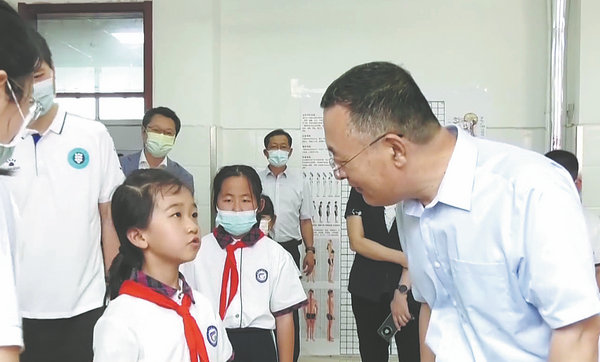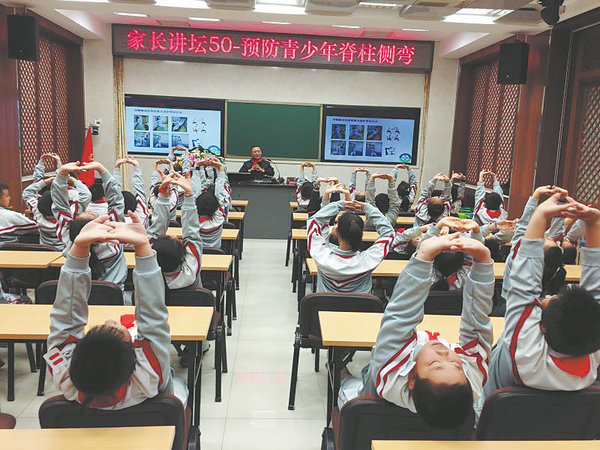

A personal mission
Li graduated from the Beijing University of Chinese Medicine in 1988, specializing in acupuncture and massage. For 20 years, he served as a physical therapist for China's national table tennis, track and field, and tennis teams.
"I'm proud that during my 15-year tenure with the table tennis team, none of the players missed a match due to injury," Li says.
After his career with Team China, Li pursued advanced studies in sports medicine, earning both a master's degree and a doctorate. Today, he also works as a doctor at the Sports Hospital of the National Institute of Sports Medicine.
However, his deeper interest in spinal health began with his daughter. In 2008, at just 7 years of age, she battled severe scoliosis, which resulted in significant damage to her jaw, facial structure, and overall well-being. Despite consulting numerous doctors, Li couldn't find a satisfactory solution.
Given his expertise in treating patients with spinal pain, Li took it upon himself to explore treatment options for his daughter. After over a decade of therapy, she has now fully recovered.
"It was a tough journey back then, enduring all the pain of treatment," Li recalls. Today, seeing his daughter standing graceful and healthy brings him immense joy.
Li also noticed that many of the patients seeking treatment and struggling with spinal disorders were adolescents. Some suffered from severe facial asymmetry due to scoliosis, which, in some cases, even led to depression.
He once treated a patient who came to him with scoliosis, but also had allergic rhinitis, autism, depression and constipation. She was in poor health and couldn't even run.
"For years, she'd been to many hospitals seeking help, and her parents felt as hopeless as I did when I first faced my daughter's condition," Li recalls.
Exams revealed her scoliosis had deformed her chest, impairing her lung and heart function, Li says. After two months of treatment, her scoliosis improved significantly, and her cardiopulmonary function recovered.
During continued care, her constipation, depression, allergic rhinitis and facial asymmetry issues improved. Many, including her parents, were amazed at the results.
"In medicine, the approach matters. While we follow standards, we mustn't be bound by tradition. Some complex cases require breaking tradition and taking a holistic approach to find breakthroughs in recovery," Li stresses.
After years of research, he discovered that many patients only see spinal issues as joint problems. However, the spine is crucial for overall health, and problems with it affect the whole body.
"The spine houses the central nervous system, and when it's deformed, it puts pressure on the nerves and blood vessels, affecting circulation and balance. This can lead to nerve pain, reduced blood flow to the brain, and hormonal imbalances. In severe cases, it can even cause vision, smell, and hearing problems," Li explains.
He points out that the physical changes and facial asymmetry caused by scoliosis are just surface signs. Many children experience memory loss, headaches, insomnia and behavioral issues due to spinal problems, but parents and teachers often overlook this.
"When we move, our posture affects the pressure on different body parts. Adolescents, in particular, are still growing, so if their posture isn't right, it can affect their development," Li says. "Many parents, teachers, and kids don't realize the consequences of poor posture."
Since witnessing his daughter's difficult recovery from scoliosis and seeing numerous adolescents and their parents struggle with the condition, Li has been passionately promoting adolescent health education.
"Scoliosis has become the third major health threat to children and teens in China, after obesity and myopia," Li states.
Data from the Chinese Preventive Medicine Association's Spinal Disease Prevention and Control Committee shows that over 5 million primary and secondary school students in China are affected by scoliosis, with around 300,000 new cases each year.
Li now leads two special projects at the General Administration of Sport of China: Adolescent Spine, Vision and Cardiovascular Health, and Public Health Education. Each project has launched various programs, such as the Adolescent Spine and Vision Health Manual and a 90-second exercise to address spinal health among young people.
But just having effective methods isn't enough; it's about putting them into action. Li emphasizes the need to build a comprehensive spinal health management system involving the government, schools, healthcare workers, teachers, parents and children.

"Emphasis on spinal health should start from birth," Li says. Educating parents on proper practices, like holding and breastfeeding infants, is crucial. Incorrect posture during breastfeeding can also lead to issues like cervical distortion in mothers, which Li says contributes to postpartum depression.
"Early education on topics like sleeping and crawling for infants is essential," he says. "This is true proactive health management, focusing on prevention."
Additionally, he says that it's essential for adolescents to undergo spinal health assessments, which can help determine their spinal health status and identify scoliosis patients early. Targeted physical exercises, such as spinal health routines, can aid intervention efforts, helping adolescents develop good posture and promote healthy growth.
"This is a prime example of blending sports and medicine," Li remarks. He stresses that in the past, the importance of prescribed exercises hadn't been fully recognized.
Some healthcare professionals used to believe that observing children with potential scoliosis was enough. However, in sports medicine, there are various methods to intervene early and prevent the need for surgery.
In 2021, the National Health Commission mandated scoliosis screening in the annual physical examinations for primary and secondary school students, adding it to their health records. Li sees this as a significant step forward, and a tangible commitment to promoting proactive health initiatives.